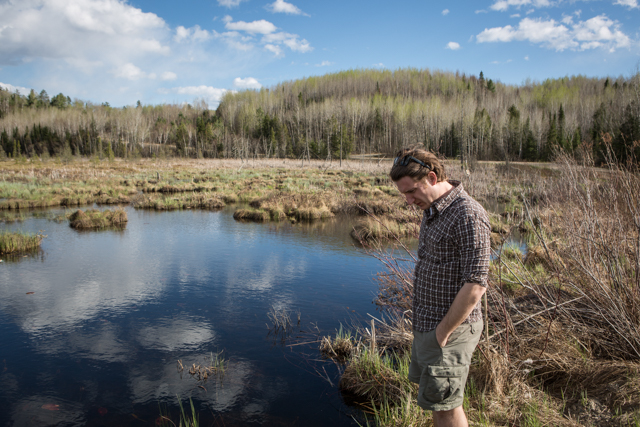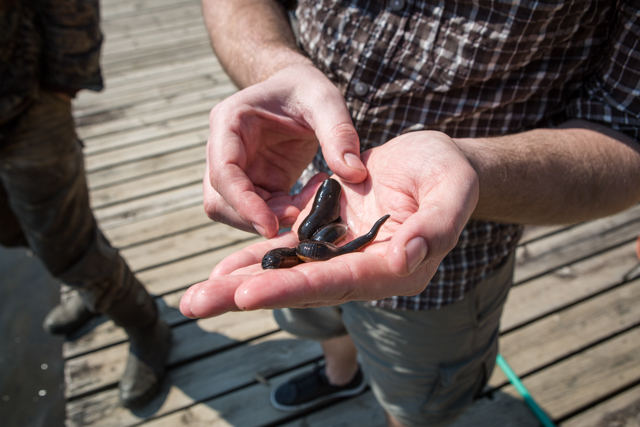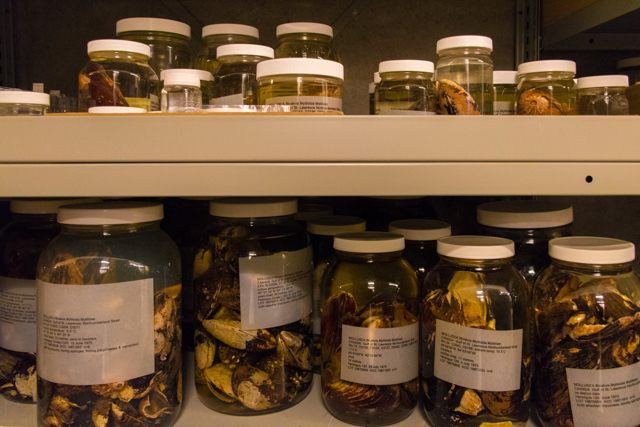Sebastian Kvist: Leech Hunter

Guest blog by Environmental Visual Communication student Sally McIntyre
Sebastian Kvist: The Face of ROM Invertebrates
Who is Sebastian Kvist?
When most people think about the Royal Ontario Museum (ROM), they think of dinosaurs or mummies. However, it is the invertebrates that live on the ocean floor and crawl through the soil that make up the most diverse collection at the ROM. Approximately 1.25 million invertebrate animals (animals lacking a backbone) are stored in the seemingly endless cabinets and shelves of the invertebrate zoology collection. The types of specimens range from mollusks to horseshoe crabs, to sea anemones to leeches and, altogether, they span across 36 different phyla (groups of organisms that share similar body plans). So who holds the daunting position of keeper of this vast museum collection? Meet Dr. Sebastian Kvist.
Dr. Kvist is the Associate Curator of Invertebrate Zoology at the ROM. He is also an Assistant Professor of Ecology and Evolutionary Biology at the University of Toronto. After completing his Ph.D. at the Richard Gilder Graduate School of the American Museum of Natural History in New York City and a 3-year postdoc period at Harvard University, Dr. Kvist moved to Toronto to fill the much needed non-entomology (non-insect) invertebrate curator position. Recognizing that the ROM is a leading natural history museum, both in terms of research and outreach, and that its collections are among the finest in North America, Dr. Kvist knew that the ROM was the best fit.
Since his arrival at the ROM in March, 2015, Dr. Kvist has used his scientific research to help drive the museum to become a leading research institution for invertebrate ecology and evolution. His research mainly focuses on trying to unravel the evolutionary relationships of a group of organisms called annelids, or segmented worms, which include bristle worms, leeches, earthworms and their relatives. More specifically, Dr. Kvist is trying to understand the evolution of blood feeding in leeches as it relates to the use of blood thinners that are secreted by the leeches during feeding.

Leech Hunting in Lake Vermilion, Minnesota
On May 7th of this year, Dr. Kvist embarked on a one-week research trip to Lake Vermilion, Minnesota to find a specific type of leech - Macrobdella decora, also known as the North American medicinal leech. The locality, Lake Vermilion, was particularly important because it is the home to the original population of Macrobdella decora, described in 1824 by Thomas Say, a famous naturalist.
The range of this leech covers a large portion of North America, including Ontario. So why would Dr. Kvist need to travel all the way to Minnesota to study a species found in the ROM’s backyard? Dr. Kvist believes that the species that we know as Macrobdella decora may in fact be divided into several different species that are anatomically similar but differ in their genetics. This would suggest that some leeches have been erroneously identified as Macrobdella decora. By comparing the original leech population in Lake Vermilion to potentially new species of Macrobdella in the future, Dr. Kvist will be able to identify separately evolving species.

Outcomes of Lake Vermilion
After getting a helpful lead from a local leech trapper, Dr. Kvist successfully recovered Macrobdella decora specimens from Lake Vermilion.
The leech rediscovery in Lake Vermilion was only the first step for Dr. Kvist. He now has three main goals. The first goal is to use the original leech population to help distinguish it from leeches that have been found throughout the distribution of Macrobdella decora but have a different genetic makeup. This will be done by comparing specific fragments of DNA between different populations (for example, Kentucky and Saskatchewan), and the original Lake Vermilion population. If the genetic differences are large enough, this suggests that these leeches could belong to a newly discovered species. The second goal is to sequence the entire genome of Macrobdella decora to figure out what genes are present. Once Dr. Kvist has identified the proteins it produces, he and his research team will be able to better comprehend the natural history of the organism, which includes how it reproduces, what kind of prey it feeds on, and how it survives during the harsh Canadian winters. The third goal is to try to understand the placement of Macrobdella decora in the leech tree of life, which will allow Dr. Kvist to interpret the evolutionary history and common ancestry between different leeches.

Linking ROM Inverts to Global Invertebrate Zoology Programs
The expertise of both current and former invertebrate curators at the ROM is essential in translating newfound knowledge about evolution and diversity to outside researchers and people on a global scale. Dr. Kvist recognizes that their roles in collecting and producing information about invertebrates help solve the puzzle of life. He believes that,
“Each piece of the puzzle takes us one step closer to unlocking the answers regarding the evolution of life on this planet, how rates of evolution have shifted, what role geography has played in the formation of taxonomic groups, how diversity is distributed across the globe, and the intricate details in how organisms are related to each other.”
Dr. Kvist’s rediscovery of the first known population of Macrobdella decora will help scientists answer questions about the past, present and future of biodiversity. It’s a lofty goal, but with the help from this unassuming bloodsucker, ROM researchers are up to the challenge.
Want to learn more about some of the invertebrates and other creepy crawlies in the ROM Collections? Come visit us this weekend for our Family Funday! Click here for More info.
